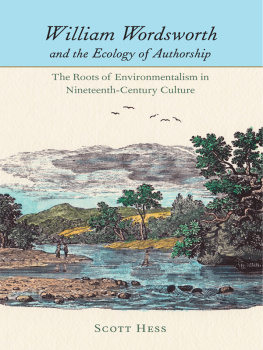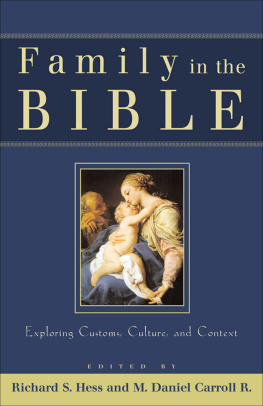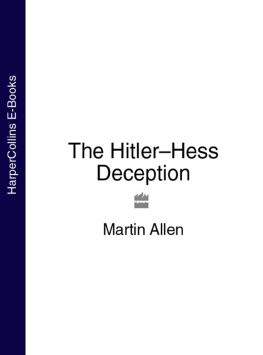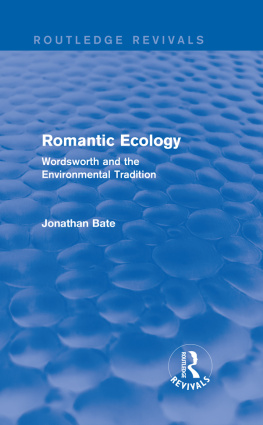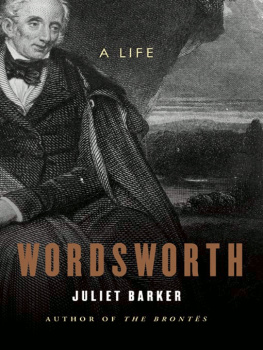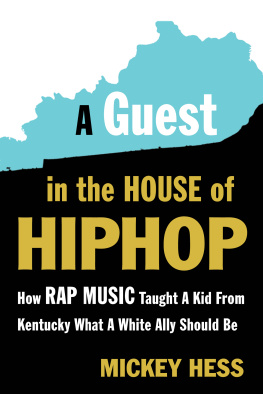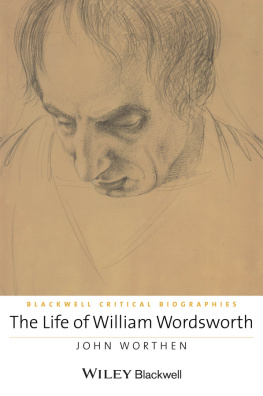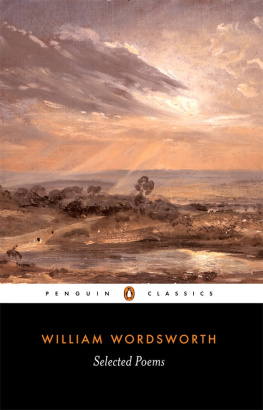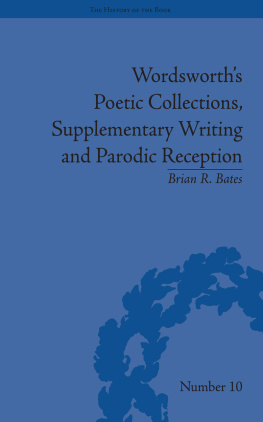William Wordsworth and the Ecology of Authorship
Under the Sign of Nature: Explorations in Ecocriticism
EDITORS
Michael P. Branch, SueEllen Campbell, John Tallmadge
SERIES CONSULTANTS
Lawrence Buell, John Elder, Scott Slovic
SERIES ADVISORY BOARD
Michael P. Cohen, Richard Kerridge, Gretchen Legler, Ian Marshall,
Dan Peck, Jennifer Price, Kent Ryden, Rebecca Solnit,
Anne Whiston Spirn, Hertha D. Sweet Wong
SCOTT HESS
William Wordsworth and the Ecology of Authorship

The Roots of Environmentalism in Nineteenth-Century Culture
UNIVERSITY OF VIRGINIA PRESS
Charlottesville & London
UNIVERSITY OF VIRGINIA PRESS
2012 by the Rector and Visitors of the University of Virginia
All rights reserved
Printed in the United States of America on acid-free paper
First published 2012
1 3 5 7 9 8 6 4 2
Library of Congress Cataloging-in-Publication Data
Hess, Scott.
William Wordsworth and the ecology of authorship : the roots of
environmentalism in nineteenth-century culture / Scott Hess.
p. cm.
Includes bibliographical references and index.
ISBN 978-0-8139-3230-9 (cloth : acid-free paper)
ISBN 978-0-8139-3232-3 (pbk. : acid-free paper)
ISBN 978-0-8139-3231-6 (ebook)
1. Wordsworth, William, 17701850KnowledgeNatural history.
2. Nature in literature. 3. Environmental policyGreat Britain
History19th century. 4. Ecology in literature. I. Title.
PR5892.N2H47 2012
821.7dc23
2011033294
This book is dedicated to my students at Earlham, who remind me every day of the social relevance and ethical responsibility of scholarship.
CONTENTS
ACKNOWLEDGMENTS
A WIDE-RANGING PROJECT SUCH AS THIS ONE, taking most of a decade to complete, depends on all kinds of support, impossible to acknowledge fully. I want to begin by thanking all those who make up the Earlham College community, who have created an intellectually and ethically vital atmosphere both inside and outside the classroom in which to explore these and related ideas. Special thanks to Larry Buell, John Tallmadge, Jim Engell, and Bridget Keegan for various, generous forms of mentorship and support across the years in all things environmental, including this project. Many others have provided both important intellectual comradeship and specific forms of support in putting together this book, including (though by no means limited to) Noah Heringman, Gary Harrison, Kevin Hutchings, Don Ulin, Lance Newman, Joel Pace, Karen Karbiener, Chuck Rzepka, Jonathan Mulrooney, Katey Castellano, and Jason Goldsmith, as well as my colleagues in English and Environmental Studies at Earlham. Thanks also to my manuscript readers and to the editorial support at the University of Virginia Press, particularly Boyd Zenner, who for her ability to move this project along so quickly can only be described (admiringly) as the Usain Bolt of editors. My deepest thanks for sustaining me, as always, go to my partner, Beth, recent coauthor of our son Xander, by far and away my/our most important work. May he grow up into a more sustainable and environmentally saner world.
of this book includes substantially revised versions of material initially published as William Wordsworth and Photographic Subjectivity, in Nineteenth-Century Literature 63, no. 3 (2008): 283320; John Clare, William Wordsworth, and the (Un)Framing of Nature, in John Clare Society Journal 27 (2008): 2744; and Tintern Abbeys Environmental Legacy, in Engaged Romanticism: Romanticism as Praxis, edited by Mark Lussier and Bruce Matsunaga (Newcastle upon Tyne, UK: Cambridge Scholars Press, 2008), 8299.
Research for the book included short-term support from the W. Jackson Bate/Douglas W. Bryant American Society for Eighteenth-Century Studies (ASECS) Houghton Library Research Fellowship, at Harvard University, and the Everett Helm Visiting Fellowship, at Lilly Library, Indiana University, as well as a number of professional development grants from Earlham College. I am grateful to these sources for their support.
William Wordsworth and the Ecology of Authorship
INTRODUCTION

AN 1846 GUIDE TO THE LAKE DISTRICT, The Scenery and Poetry of the English Lakes, opens with two engravings. On the left side, a well-dressed man gestures to his female companion at the waterfall at Scale Force, as if pointing out some feature for her appreciation. On the right, a more fanciful engraving presents what looks like a large bas-relief inscription of William Wordsworths head, as if for a tomb or medallion, inscribed with the name W. Wordsworth, with the books own title and author printed as if engraved in the stone base beneath. Labeled paintings of S. T. Coleridge and Robert Southey lean to either side of this central monument, with a painters easel and color box lying at bottom center. Behind the monument rises a distant scene of lakes and mountains, framed in the middle ground by trees to right and left.
This illustration, a kind of alternative title page for the book, presents the Lake District as an aesthetic sphere, dominated by the arts in general and poets in particular, but above all by the central, commanding presence of William Wordsworth. The area had long been associated with the visual arts, as the various artworks and insignia of painting suggest. The framing side-screens of the trees also indicate the continuing legacy of the picturesque. By the time of the books publication in 1846, however, literature had pushed painting aside as the defining art of the Lake District, as it has in the engraving, creating a literary landscape dominated by the specific writers associated with the area. As the engravings iconology suggests,
This books pairing of scenery and poetry illustrates a larger tendency in nineteenth-century Anglophone culture: the construction of a high-aesthetic version of nature in relation to individual authors and, through them, also individual readers. This version of nature, linked to a generalized model of autonomous, self-constructed identity, presented itself in opposition to the social and economic world of modernity, but in a wider sense it emerged out of, supported, and even helped to construct that modernity. At the beginning of Wordsworths Prelude, he claims to leave behind the bondage of the City and the burthen of my own unnatural self in order to reassume his individual freedom and autonomy in nature. Yet Wordsworths identity as a poet of nature continued to depend on the City, the place where his books were physically produced, disseminated, and for the most part read. Wordsworths turn to nature, in this sense, does not really escape the social world, but instead fashions a new, less direct form of social and discursive relationship. Through this discourse of nature, as through art and literature generally, individual author(s) and reader(s) can construct their true selves in relation to one another through seemingly autonomous imaginative activity without actually meeting in person, while at the same time identifying together as part of the new middle-class cultural model of the nation. Wordsworths turn to nature in The Prelude, as throughout his oeuvre, is thus also a turn to a particular form of social organization and culture. These versions of nature, genius, individualized authorial identity, middle-class high culture, and the autonomous deep self in general emerged interdependently as parts of a single, modern discursive system: what this book calls the ecology of authorship.

